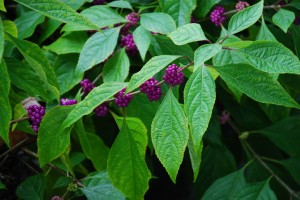The stunning purple berries of beautyberry (Callicarpa spp.) are eye-catching in late summer. White fruited varieties are also sold, but the purple forms are most popular. This 6-8 foot shrub has medium green, 3-5 inch long foliage spring thru summer. Autumn leaf color adds little, the deciduous leaves turning purple to pale yellow, shriveling, and abcising.
The purple fruit clusters are electifying, perhaps nature at its gaudiest. Individual fruits measure 1/4 inch or less in size, and clustered together around the stems, creating quite a show. Numerous species of birds feed on the fruits, either from the Japanese (C. dichotima) and native (C. americana) forms.
Clusters of pink or lavender colored flowers open in mid-July, and are mostly unnoticed because of their small size; flowers are somewhat hidden within the thick foliage.
Grow beautyberry so the magnificent late summer fruit display may be easily seen. Beautyberry thrives in full sun to partial shade (as little as 1 hour of sunlight needed). Its soil needs are average, although beautyberry grows and fruits best under full day sun and in moist well drained soils. Mulch plants to reduce weeds and to conserve soil moisture.
Prune to remove winter injured branches (in USDA zone 5) and to open this dense growing shrub to additional sunlight. Heavier pruning may be required to control its wild-like nature further south. All pruning should be completed by mid-spring. Flowers and fruits form on new season’s growth.
Viable seeds are dispersed into your landscape and your neighbors’ yards as well. Invasiveness is currently unproven , so plant the native species just in case. The foliage is rarely troubled by disease or pest problems.


 Posted in
Posted in 
